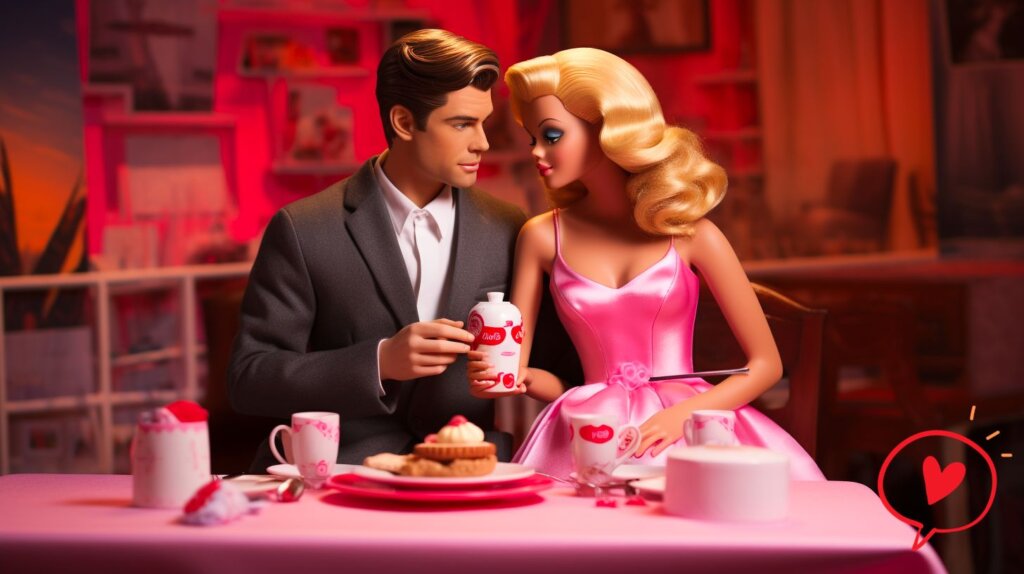“Get a grip!” I said, “The Barbie aisle is gone.” After 45 years as the Queen Bee of dolldom, Barbie is just one of many choices in what is now not just a toy aisle but a whole doll section. Sure, Barbie holds the first and premiere position. Her Fashion Mall play set (with over 100 pieces) greets everyone who walks in the front door; and it leads naturally to row after row of the usual doll friends, outfits, accessories, and play sets.
But the sweet nymph who has weathered so many decades of change in American culture is confronted this year by a rival in the school yard, The Bratz, who have set up shop in an equal length of shelf space across the way and are, frankly, cleaning Barbie’s clock.
Although they were introduced only three years ago at the 2001 Toy Fair in New York, The Bratz — Cloe, Dana, Jade, Sasha, Yasmin, Fianna, Roxxi, Meygan and Phoebe — have won the People’s Choice Toy of The Year award three years running and last Christmas supplanted Barbie as the number one selling fashion doll in America.
With their flashy trash outfits and, like, so totally kickin’ attitude, they are mall rats squared off against the prom queen and, in the crucial 8-10 year old girl market, a marketing phenomenon. In only three years, MGA Entertainment of Van Nuys, California, the creator, has sold 50 million dolls and last year moved $600 million of Bratz dolls and accessories.
The success of Bratz has sparked major changes in the way Mattel markets its own Barbie line. Last year, the company introducted a competing hipster doll line called Flavas that so tanked in the stores it was pulled in less than 12 months. This year, Mattel announced in February that Barbie was dumping her boyfriend of 43 years, Ken, and as a single girl again, would become one in a clique of “Cali Girls” – Chelsea, NoLee, Barbie, Madison, Kenzie and Delancey – who dress in Butterfly Punk outfits and chase hottie boyfriends named Sutton, Hudson and River around “Jammin Jamaica” and a 30-piece “Party Pad” that comes complete with makeout couch, munchies and “dance-worthy music. “
If you follow along Barbie’s wall of accessories, you will see Barbie’s new friends have not brought much new thinking to the play toys Mattel thinks every Barbie owner wants to have. Beside the usual cosmetic and hair-brushing kits, you can buy a Barbie karaoke boombox, a B-Bright laptop computer with 10 sound-chip activities, a “Sparkle ‘n’ Style” vacuum cleaner that makes real electronic noise, a cash register, and a $70 shopping cart with a handheld electronic scanner that can read 24 separate barcode items.
You can also buy, on the communications front, a wireless video camera that lets you pretend to be an actress on your own TV; an “imessage” plastic cell phone to call Barbie, hear Barbie or send Barbie’s voice to a friend; or — by going to the Barbie website — sign up for a special bedtime or birthday call from Barbie ($2 for one, or 6 for $9).
But none of these items are jumping off the shelves. On the day I was in Toys R Us, you could shoot a cannon down the Barbie aisle and not hit a pigtail. Oh there was an occasional mom or grandmother, but across the way in Bratz, kids and sisters and moms were shopping with lists in their hands. What happened to Barbie? Or as my wife laments, what has happened to us?
The first Barbie came on the scene in 1959 and it all but created the fashion doll category of toys. Barbie was a girl of her times, pretty, smart and a role model for young women – like an airline stewardess. Through decades of change, even the turbulent Sixties and Seventies, Barbie kept pace with the times by changing outfits.
For young girls, dolls were a way of trying on lifestyles. You could make Barbie be anything you want to be. So Mattel kept expanding out the franchise with new outfits – Malibu Barbie, Rancho Barbie, Rock N Roll Barbie – until it had every lifestyle covered. All but one, that is. Rebel Barbie. You cannot make Barbie not be wholesome.
The Bratz are the anti-Barbie. They are marketed as “Girls with a Passion for Fashion” ™ who groove on down while they party up, and like to go “hanging at the mall with the funk fashionistas.” They are outsiders at school and bad girls on the street. Barbie rides around in pink corvettes. The Bratz hitch rides in limos, motorcycles, convertibles and Wild Safari jeeps. Barbie has outfits. The Bratz have thrift shop pieces they thrown together for that funkadelic look. Barbie is pink. The Bratz are black. Even the Bratz logo looks like graffiti scrawled on the side of a railroad car.
In the head to head competition between the two, Barbie is strongest among the younger set. With Barbie spin-off lines like “Fairytopia” and “The Princess and the Pauper.” Mattel continues to dominate the fantasy world of 3-7 year olds. But as girls mature into the 8-12 range, Bratz becomes a vehicle for girls to work out their individualization.
Given the limited choices, the Bratz stuff is just plain cooler. Barbie has a Party Pad and a Dream House. The Bratz have a Ski Lodge, a Dance-N-Skate Club, a Sushi Lounge, an E-Café and a “Kick It Cool” Pad that features a chillout Jacuzzi, stylin’ sundeck and kickin’ kitchen. Would you rather pretend to be talking to Barbie on a plastic toy cell or use the Bratz purple-gloss “Luscious Lips” cordless phone to call your real friends? Barbie has a boombox. The Bratz have a shower radio, earmuff headphones and a personal journal complete with an electronic Love Life Analyzer.
The Bratz also have proven far more nimble on digital front. Their website makes extensive use of Flash animations for interactive games like “Truth or Dare”, features a rock video “Spinfectious” by a girl band named Swarm, and has a secret place where you can “get the 411 on everyone.” One of the prime new attractions this year (sold out in many stores) is “Bratz The Video” – a super cool DVD with a free vinyl Bratz purse and special features like the Bratz Love Horoscope and Bratz Fashion Mall Game.
For a glimpse into the life of the Bratz, check out this synopsis of the DVD:
All Yasmin, Cloe, Sasha and Jade can think about is the prom . . .until they get a last-minute homework assignment on self-expression. How will they get ready for the funky formal and turn in a kickin’ cool project? Leave it to The Girls with a Passion for Fashion ™ to “express themselves” with a scorchin’ home video about their superstylin’ prom prep. . . even as a secret gossip columnist begins to attack the pack in the school paper! But with a lil’ hard work and some far-out flash ‘n’ dash, the girls just might create a high-fashion hit – and save the prom!
Barbie is trying to keep up. Mattel also has a movie packaged into Barbie’s Masquerade Clothes (but no one cares); it also offers girls six CD-Rom games (three of which somehow seem to involve horses) and is pushing the concept of “Barbie Radio” with a new CD featuring the song “Where’d You Get That” from the Barbie commercial and six other tunes licensed from T the likes of The B-52’s, Sugar Ray, Ben Jelen, Lillix and Cherie. (Always a step ahead, The Bratz website has a photo gallery showing presumed celebrities at a Teen Fashion Show holding their product. They include Usher, Avril Lavigne, Hoobastank, Andre from Outkast, Paris Hilton and Kelly Osbourne.)
MGA Entertainment is pretty cocky about its prospects this Christmas, boasting that its shelf space in toy stores has already grown 4-8 times in the first six months of 2004 and predicting it will end the year with a 70% share of the fashion doll market. In a toy category that generates $2.8 billion a year in sales, MGA is expecting Bratz will get over $1 billion of it.
No one is holding a tag day for Mattel. The Barbie lines for the younger set – Fairytopia and Princess – are doing well. And if, after 45 years, Barbie is headed to the old age home, Mattel also holds the franchise on American Girl dolls, which it acquired in 1998 for $700 million. Selling exclusively by catalog and in high end Mecca stores, American Girl had revenues of $370 million last year and was the number three selling doll in America.
All in all, with outlets in 70 countries and product available in 10 languages, Mattel sold some $1.7 billion of Barbie goods worldwide last year.
The impressionable set may be fast slipping into the clutches of the Bratz pack, but there is some good news for my wife and others who grew up in the Barbie tradition. Mattel is coming out next year with a new Barbie Couture Collection of adult clothes for women. Your favorite Barbie shoes, coats and cocktail dresses will soon be available in a full range of adult sizes. You just won’t be able to buy them in the doll section of a toy store.




